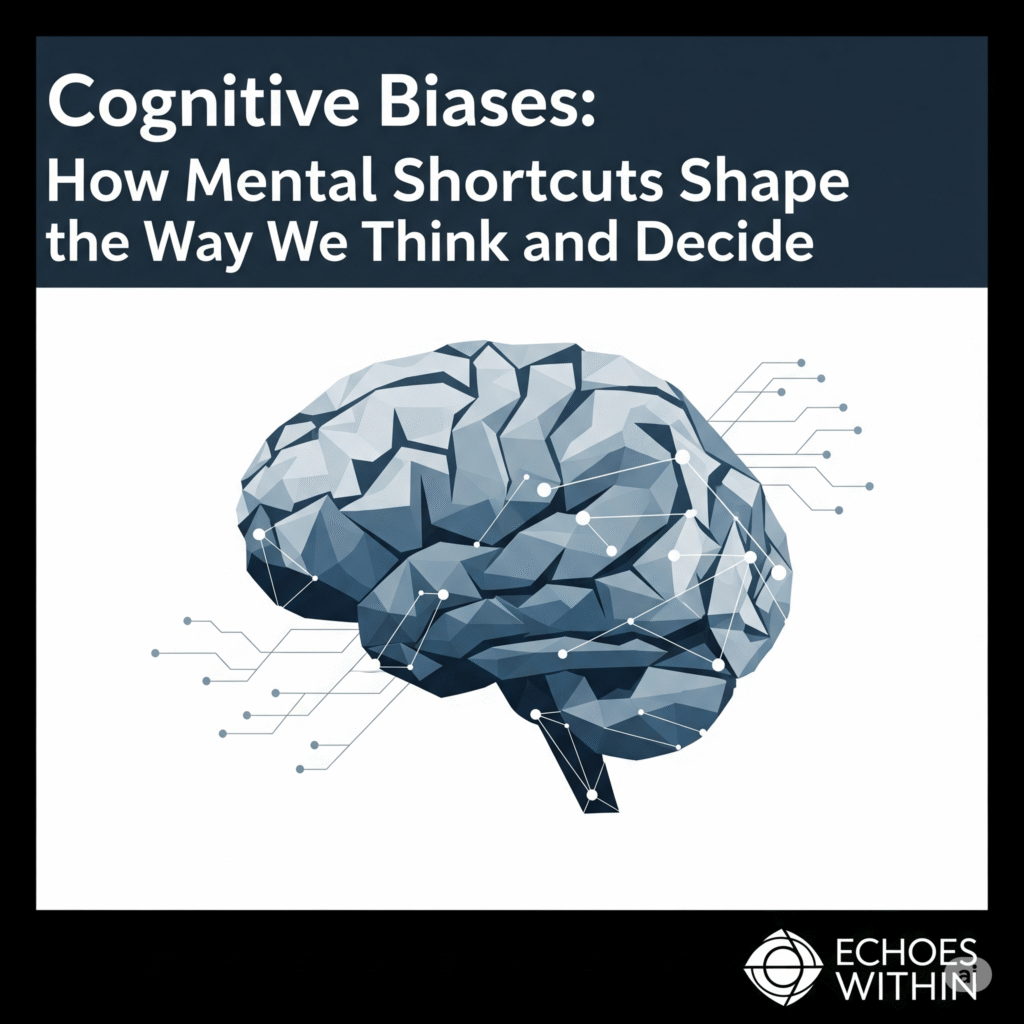Introduction: What Are Cognitive Biases?
Have you ever made a quick decision that you later regretted? Or judged someone too fast without knowing the full story? If so, you’ve experienced something called a cognitive bias. These are mental shortcuts your brain takes to make thinking easier. But often, they lead to mistakes in how we see things, judge others, or make decisions.

In this blog post, we’ll explore what cognitive biases are, how they affect our thinking, and how you can spot and avoid them in daily life.
1. Why Do We Have Cognitive Biases?
Every day, we face thousands of choices and bits of information. To handle all this, our brain looks for shortcuts. These mental shortcuts—also called heuristics—help us make quick decisions without too much effort.
However, these shortcuts are not always right. They can cause us to:
-
Ignore important facts
-
Jump to wrong conclusions
-
Repeat the same mistakes
This is where cognitive biases in decision-making come in. They save time, but sometimes lead us in the wrong direction.
2. Common Types of Cognitive Biases
Let’s look at some of the most common and simple examples of cognitive biases:
✅ Confirmation Bias
You only notice or believe information that supports your existing ideas.
📌 Example: You think a certain food is bad for you, so you only read articles that say it’s harmful and ignore the ones that say it’s okay.
✅ Anchoring Bias
You rely too much on the first piece of information you hear.
📌 Example: If the first price you hear for a phone is $800, you’ll compare every other phone to that, even if the quality is different.
✅ Availability Bias
You make decisions based on information that’s easiest to remember.
📌 Example: After watching news about plane crashes, you may think flying is unsafe, though it’s actually very safe.
✅ Halo Effect
You judge a person’s whole character based on one good thing about them.
📌 Example: If someone is attractive or well-dressed, you might assume they’re smart or kind—even if you know nothing else about them.
✅ Overconfidence Bias
You believe your opinions or predictions are more accurate than they actually are.
📌 Example: You may feel sure you’ll win a game or finish work on time, even when chances are low.
3. How These Biases Affect Decision Making
Cognitive biases can change the way you:
-
Choose a product
-
Trust a person
-
Vote for a leader
-
Handle conflict
-
Spend money
Even when you think you’re being logical, your brain might be leaning on a bias. This can lead to poor judgment, missed opportunities, or unfair decisions.
4. Why It Matters in Everyday Life
Understanding cognitive biases helps you:
-
Think more clearly
-
Make better choices
-
Avoid being tricked or misled
-
Improve relationships and fairness
Whether you’re shopping, working, or talking to others, being aware of your own biases can make a big difference in how you act and think.
5. How to Spot and Reduce Bias
You can’t remove all biases, but you can reduce their effect by doing the following:
✔️ Pause Before You Decide
Take a moment to think instead of acting on impulse.
✔️ Ask for Other Views
Talk to people who have different opinions or backgrounds.
✔️ Check the Facts
Look for real data, not just what “feels right.”
✔️ Be Humble
Admit that you might be wrong or biased, and stay open to change.
Conclusion: Think Smarter by Noticing Your Biases
Cognitive biases are part of being human. They help us think fast, but they also cause blind spots in our thinking. By learning to recognise them, you can make wiser decisions, be fairer, and understand others better.
So the next time you’re about to judge a person or make a choice, pause, think, and ask yourself:
“Am I seeing the whole picture, or just what my brain wants to see?”
📢 You Can Also Read:
- Voluntary Childlessness: Challenging Societal Norms
- Polyamory and Open Relationships: Redefining Love in the Modern Age
- The Pursuit of Perfectionism: When Good Enough Isn’t Enough
- Extreme Body Modification: Pushing the Boundaries of the Human Form
- Why We Mindlessly Scroll: The Psychology Behind Mobile Scrolling in Free Time — and How to Break the Habit
- Daniel Kahneman & Amos Tversky’s Work (Prospect Theory, Heuristics and Biases):
- American Psychological Association (APA)

